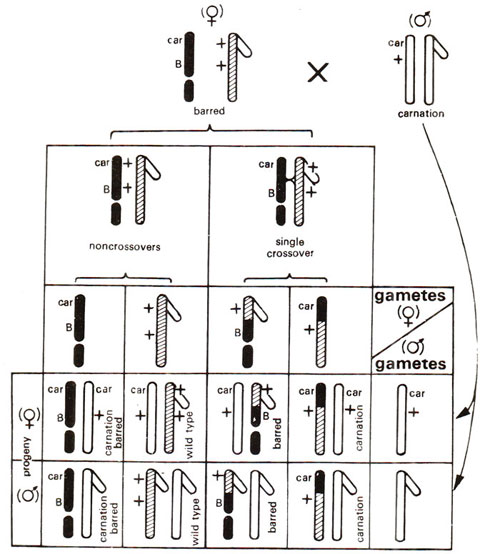Discussion in preceding sections of this section is based on the study of progeny in BC
1 generation or the testcross progeny. In such progenies, lack of independent assortment demonstrated linkage and presence of recombinants showed crossing over. It was concluded that crossing over should be the result of exchange of chromosome segments. However, since homologous chromosomes normally exchange reciprocal segments, resulting chromosomes will exhibit no morphological differences. Therefore, except the visible chiasmata, there is no other cytological observation which will substantiate that actual exchange of chromosome segments really takes place.
However, it is not necessary that chiasmata should be associated with exchange of chromosome segments. Therefore, to demonstrate that crossing over is associated with actual exchange of chromosome segments, special experiments were devised by G. Stern in
Drosophila and by
H.S. Creighton and
B. McCHntock in corn. These experiments were reported in 1931 and had utilized chromosomes, whose morphology was altered due to chromosomal aberrations in order to make it identifiable from its homologue. Another experiment was conducted by M. Meselson and J. Weigle in lambda
(λ
) phage, demonstrating exchange of DNA segments.

Fig. 10.16. Stern's experiment to demonstrate cytological crossing over.
Stern's experiment in Drosophila
Drosophila (fruitfly) stocks carrying translocations were utilised by
C. Stern in order to produce a female
Drosophila having a part of Y-chromosome attached to one of the two X-chromosomes. The
other X-chromosome of this female fly was also marked (identifiable due to distinct morphology) and consisted of two approximately equal fragments, each carrying its centromere. These two X-chromosomes in the female fly could be distinguished not only from each other, but also from normal X-chromosome under the microscope.
In the above female fly, one of the two fragments of an X-chromosome carried mutant alleles for
carnation eye
(car is recessive showing light eye colour) and
barred eye
(B is dominant showing narrower eyes). The other X-chromosome, having a part of Y attached, carried normal alleles of these two genes, so that the female heterozygote
for both these genes
(car B/+ +) had barred eyes (but normal eye colour, since
car is recessive to +). Such females were crossed with male flies having recessive alleles for both these genes
(car, +). In such a situation, this makes a simple testcross. If no crossing over takes place between the two genes in question, two types of gametes i.e.,
car B and ++ will be produced from the female flies. Crossing over will give two additional types ot gametes i.e.,
car + and +
B (Figure 10.16). Due to fertilization of two types of non-crossover and the other two types of crossover gametes by male gametes carrying X-chromosome (
car +), four kinds of female flies will be produced. Another four kinds of male flies will be produced due to fertilization by Y carrying male gametes (Fig. 10.16).

Fig. 10.16. Stern's experiment to demonstrate cytological crossing over.
The flies which are classified as crossovers on the basis of phenotype i.e., carnation (with normal eye shape) and barred (with normal eye colour) were studied cytologically. It was found that carnation flies did not have any fragmented X-chromosome, but rather had normal X-chromosome. On the other hand, barred flies had a fragmented X-chromosome with a segment of Y-chromosome attached to one of the two fragments of X-chromosome. Such cytological observations suggested that genetic crossing over was accompanied with an actual exchange of chromosome segments.





